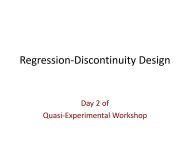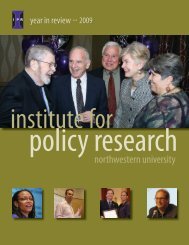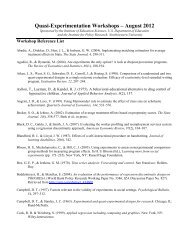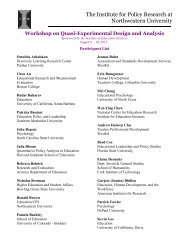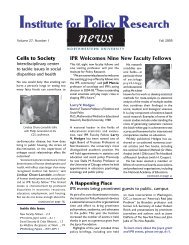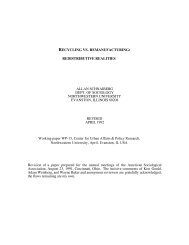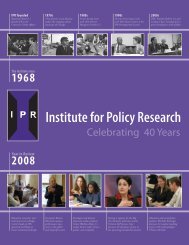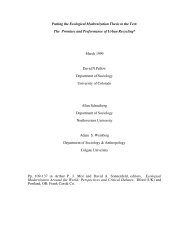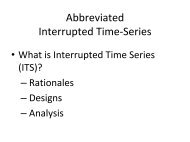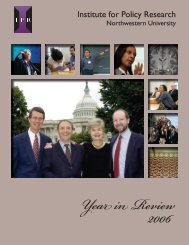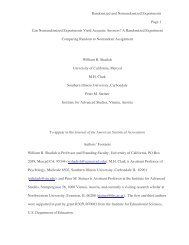Highlights of 2011 - Institute for Policy Research - Northwestern ...
Highlights of 2011 - Institute for Policy Research - Northwestern ...
Highlights of 2011 - Institute for Policy Research - Northwestern ...
You also want an ePaper? Increase the reach of your titles
YUMPU automatically turns print PDFs into web optimized ePapers that Google loves.
looks at how to represent and combine the results <strong>of</strong> several<br />
experiments, which can sometimes yield multiple measures<br />
<strong>of</strong> the same outcome construct. The results will improve the<br />
precision <strong>of</strong> estimates and suggest new ways to use the results<br />
<strong>of</strong> randomized experiments in education.<br />
About the Program<br />
New Parameters <strong>for</strong> State Test Scores<br />
IES is also sponsoring a project co-led by Hedges that seeks to<br />
design new parameters <strong>for</strong> education experiments at the state,<br />
local, school, and classroom levels. Many current education<br />
experiments use designs that involve the random assignment<br />
<strong>of</strong> entire pre-existing groups (e.g., classrooms and schools) to<br />
treatments, but these groups are not themselves composed<br />
at random. As a result, individuals in the same group tend to<br />
be more alike than individuals in different groups, so results<br />
obtained from single-district data might be too imprecise to<br />
provide useful guidance. This project will decompose the<br />
total variation <strong>of</strong> state achievement test scores to estimate<br />
experiment design parameters <strong>for</strong> students in particular grades<br />
in each state. The new parameters will take into account<br />
achievement status and year-to-year improvement <strong>for</strong> a<br />
particular grade, as well as demographic covariates. Designs will<br />
also differ across different school contexts with a focus on lowper<strong>for</strong>ming<br />
schools, schools serving low-income populations, or<br />
schools with large minority populations.<br />
Pretreatment Effects in Political<br />
Communication Experiments<br />
<strong>Research</strong> on political communication effects has seen great<br />
progress over the past 25 years. A key ingredient underlying<br />
these advances is the increased usage <strong>of</strong> experiments that<br />
demonstrate how communications influence opinions and<br />
behaviors. But virtually none <strong>of</strong> these studies pay attention to<br />
events that occur be<strong>for</strong>e the experiment, or “pretreatment<br />
events.” Given that many, if not most, researchers design<br />
experiments aimed at capturing “real world” political<br />
communications, the likelihood <strong>of</strong> pretreatment contamination<br />
is substantial. In a new working paper, IPR political scientist<br />
James Druckman and IPR graduate research assistant Thomas<br />
Leeper explore how and when the pretreatment environment<br />
affects experimental outcomes. They present two studies—<br />
one where they controlled the pretreatment environment and<br />
one where it naturally occurred—to show how pretreatment<br />
effects influence experimental outcomes, presenting the<br />
first conclusive evidence <strong>of</strong> a pretreatment dynamic. More<br />
importantly, they identify the conditions under which these<br />
effects occur. When accounting <strong>for</strong> the pretreatment context,<br />
they found that average experimental treatment effects might<br />
miss important variations among subgroups. Furthermore, the<br />
non-existence <strong>of</strong> experimental effects might stem from a large<br />
number <strong>of</strong> individuals <strong>for</strong>ming strong attitudes in response to<br />
earlier communications prior to the experiment, making them<br />
Larry Hedges, Chair<br />
Most researchers and academics tend to stick<br />
with the research methods they know best,<br />
learned mainly in graduate school—even<br />
though those methods might not represent<br />
current best practices or the most appropriate<br />
method. This is why statistician and education<br />
researcher Larry Hedges, with the support <strong>of</strong> a<br />
group <strong>of</strong> distinguished interdisciplinary scholars,<br />
launched the Center <strong>for</strong> Improving Methods <strong>for</strong><br />
Quantitative <strong>Policy</strong> <strong>Research</strong>, or Q-Center, at<br />
IPR. The work <strong>of</strong> Q-Center faculty <strong>of</strong>ten overlaps<br />
with IPR’s Education <strong>Policy</strong> researchers.<br />
more likely to reject subsequent contrary arguments. They<br />
argue that, under certain conditions, attending to pretreatment<br />
dynamics leads to a more accurate portrait <strong>of</strong> the mass public<br />
and its political flexibility.<br />
Party Heterogeneity in Candidates<br />
IPR political scientist Georgia Kernell is examining the<br />
conditions under which parties benefit from fielding more or<br />
less heterogeneous candidate teams. While most spatial voting<br />
models assume or imply that homogeneous candidate teams<br />
<strong>of</strong>fer parties the best prospect <strong>for</strong> winning elections—in reality,<br />
candidates from the same political party <strong>of</strong>ten adopt divergent<br />
policy positions. She reconciles theory and reality by identifying<br />
a strategic rationale <strong>for</strong> political parties to recruit a diverse pool<br />
<strong>of</strong> candidates. Kernell develops a spatial model in which two<br />
parties each select a distribution <strong>of</strong> candidates to compete in<br />
an upcoming election. The model demonstrates that parties<br />
positioned close to the median voter should field a more<br />
homogeneous set <strong>of</strong> candidates than parties with plat<strong>for</strong>ms<br />
that are more distant. Kernell tests this prediction using data on<br />
the policy positions <strong>of</strong> Democratic and Republican candidates<br />
<strong>for</strong> congressional and state legislative elections since 1990.<br />
In line with the model’s predictions, she finds that minority<br />
parties—presumably more distant from the median voter—<br />
are more heterogeneous than majority parties.<br />
50 INSTITUTE FOR POLICY RESEARCH



